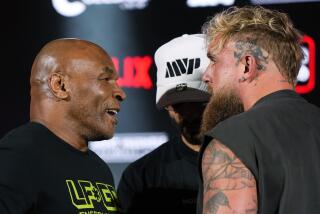COMMENTARY : Only Here, and Only in Boxing
- Share via
LAS VEGAS — Once again, the sport of boxing sent its fans to the exits not knowing whether to grumble or giggle.
On a Saturday night in the heat of this desert city known almost singularly for a section called “the Strip,” the 7,210 in attendance and the many thousands more who purchased the fight on pay-per-view felt somewhat more naked in their wallets.
Had this not been only 21 days after McNeeley-Tyson, it might not have been so bad that Genaro Hernandez stopped his own fight against Oscar De La Hoya after the sixth round by walking up to referee Richard Steele with gloves face down. Years ago, Roberto Duran said his no mas . Hernandez only gestured his.
Had not the stench of McNeeley-Tyson still been floating amid the slot machines and blackjack tables, it would have been a bit easier to rationalize that what happened in this World Boxing Organization lightweight title fight wasn’t all that unusual or open to criticism. After all, Hernandez, an aging warrior experiencing his best--and perhaps last--great payday with a guaranteed purse of $500,000, did get his nose broken by a younger, tougher, fitter and faster De La Hoya.
Sure, fighters frequently go on with broken noses, but doctors afterward called Hernandez’s one of the worst they’d seen in a while. And by the sixth round, De La Hoya was clearly in control anyway, bloodying the face of Hernandez while staying totally unmarked himself. As Muhammad Ali would have said, De La Hoya was still pretty.
Had not the stench of McNeeley-Tyson still been drifting over the chorus girls and the exploding volcanoes, it would have been a bit easier to rationalize that it was OK for Hernandez to do what he did and then say afterward, “I was looking out for my own safety.”
It isn’t really that boxing has an image problem, because boxing never really had an image. Boxing is whatever it happens to be on a given night, even if, on a disproportionate number of those given nights, boxing does more taking than giving.
This is, after all, the sport that gave us Leon Spinks and Don King. On the other hand, it is also the sport that gave us Ali and George Foreman, without whom the world of sports would be considerably less rich.
And Saturday night, it was the sport that gave us both a marvelously sculpted and talented De La Hoya, as well as a marvelously unsculpted and untalented Butterbean. Yes Butterbean, who, in the tradition of all cosmically talented athletes, carries only a single name.
Butterbean fought a four-rounder just before the main event. Butterbean won, extending his record to 10-0. He won, mostly because he was the aggressor, and he was the aggressor, mostly because when he got his weight shifted forward, there was no shifting it back.
Butterbean is 6 feet and 310 pounds. Butterbean jiggled in places no other mortal could grow to. Butterbean wore red, white and blue stars-and-stripes trunks. Betsy Ross could not have sewn them because Betsy would not have been able to acquire enough material. Butterbean--his closest friends call him “Bean”--is a dozen or so filet mignons away from the cardiac care unit, yet boxing let him plop around a ring for half an hour in temperatures in the mid-80s.
Of all the things that happened here Saturday night, including a pretty good 12-rounder that ended up a draw for the World Boxing Union featherweight title between Clarence (Bones) Adams and Kevin Kelley and a victory by disqualification for sharp-punching James Toney, not to mention a dazzling show by De La Hoya while it lasted, the fans loved Butterbean the best.
Maybe the fans deserve naked wallets.
More to Read
Go beyond the scoreboard
Get the latest on L.A.'s teams in the daily Sports Report newsletter.
You may occasionally receive promotional content from the Los Angeles Times.











